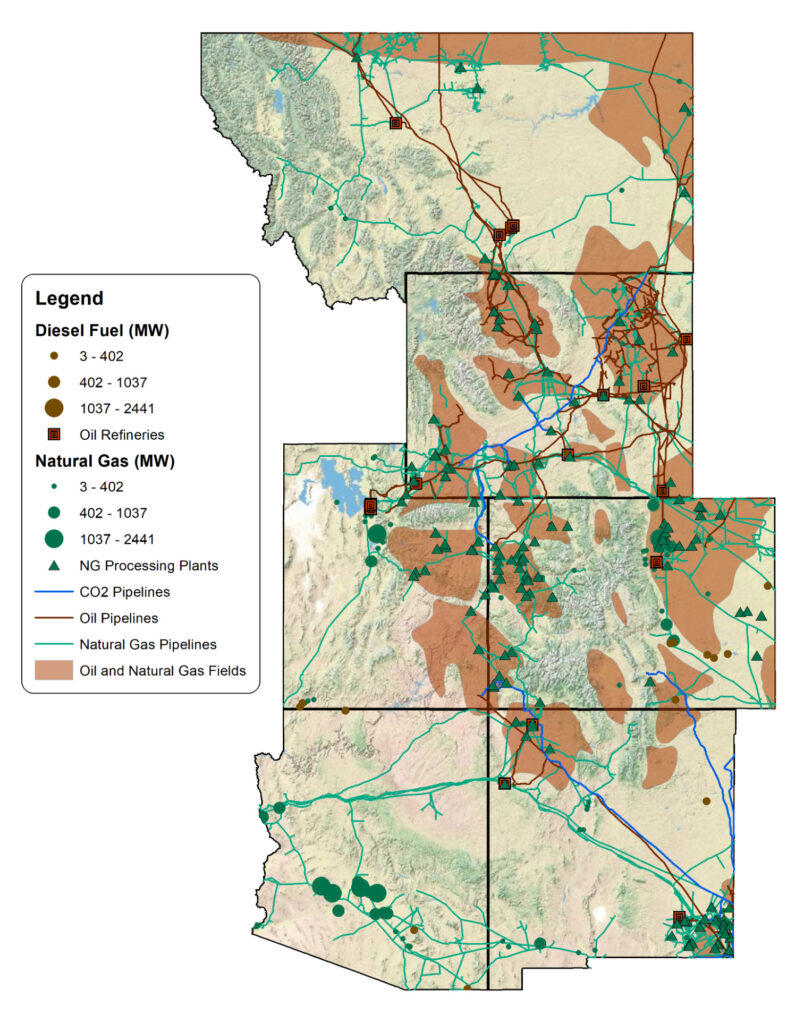Electricity
Electricity is essential to modern life but it comes at a price. In the U.S., the majority of electricity is generated from burning fossil fuels such as coal and natural gas, a process that produces significant greenhouse gas emissions. Increasingly, electricity markets are shifting away from fossil fuels due to many drivers—increases in consumer demand for cleaner energy, changes in policy, and challenges associated with financing for new fossil-based power plants. This shift promises to change the electricity market in profound ways over the next five to ten years and beyond.
This change is particularly relevant to the Intermountain West states, which produce and sell excess electricity, providing significant revenue for the region. Additionally, considerable investment in infrastructure for coal and natural gas generation of electricity has already been made, leaving some producers needing to find ways to compete in a lower-carbon electricity market. Indeed, the Intermountain West is already experiencing the impacts in a shifting electricity market, with loss of revenue and jobs in rural communities (including sovereign nations). So, how will the Intermountain West move toward a cleaner electricity economy while maintaining the economic benefits it currently enjoys?
Increasing Demand
Global demand for electricity is surging and expected to increase by over 2.5% annually through 2024. Domestically, increased demand has stretched the electricity economy’s ability to keep pace, despite growth in the renewables sector. This trend is expected to continue as the transportation sector introduces more electric vehicles, particularly in the West Coast market but also within the Intermountain region. Looking ahead, how will the Intermountain West meet the challenge of having to supply more using cleaner resources? Several options and strategies are being considered including electrification of the region’s sovereign nations using small-scale, community build out solar technology. But what is practical for one part of the region, may not be for another, which is why I-WEST’s place-based approach is vital to finding relevant, lasting solutions.

Electricity Generation in the Intermountain West
Coal and natural gas power production still dominates the landscape of a region rich in fossil fuel resources. Electricity generated this way releases roughly 180 million tons of carbon dioxide into the atmosphere each year. There is an urgent need to retrofit coal, natural gas, and other CO2-emitting facilities with CCUS technology, and many projects are exploring this option in the Intermountain West. These facilities can play an important role in a regional energy transition by maintaining baseload power and balancing power produced by solar and wind while alternative options (e.g., grid-scale battery storage) develop. However, in the shifting electricity market, this can only occur if the CO2 emissions are addressed.
In addition to capturing emissions from fossil-based systems, the Intermountain West can take advantage of its abundant renewable resources—plentiful sunshine, sustained wind, and geothermal heat. As the adjacent map reflects, a large number of renewable energy sources and transmission lines are already online and that number is expected to increase.
Though renewables generate clean electricity, they have limitations. For one, solar and wind generate most of their energy at certain parts of the day, and this intermittency doesn’t always align with peak power needs. Thus, any grid in which renewables play a major part has the need to “load balance” or store generated energy to be used when usage goes up. One strategy is the use of batteries, but availability of technology hasn’t advanced sufficiently to make this feasible on a large scale in the near term. Another way to offset these limitations is to rely on natural-gas turbines that can be cycled up-and-down during the day; this could take advantage of abundant regional natural gas, but as noted, the carbon dioxide byproduct must be captured and stored or utilized sustainably.
I-WEST is assessing the current state of the region’s electricity infrastructure and economy to answer some key questions including: How much additional renewable energy can be added to the system given the existing facilities and grid without load-balancing or storage? How would changes in distributed generation (e.g., home or community scale build out in solar) fit with the existing facilities/grid? What are the region’s infrastructure needs over the next ten years to get us to net-zero carbon? How does evolution of the electricity economy intersect with the other symbiotic energy economies in the region?



